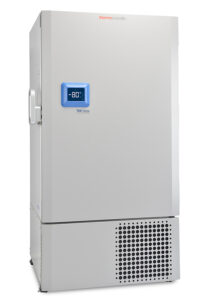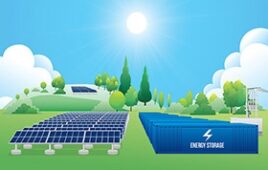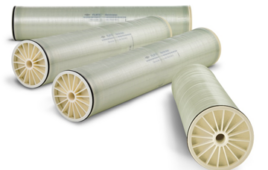By Adam Carter, Global Products Manager, Thermo Fisher Scientific

Adam Carter, Thermo Fisher Scientific
Working in a laboratory, you cannot help but notice the amount of waste material and energy use that comes from experiments. From the frequent use of single-use plastics and a reliance on transnational shipping of reagents, to the dependency on high-energy-consumption equipment like -80° C freezers for the long-term storage of samples, there is no escaping the fact that the science sector is a major contributor to global CO2 emissions. Indeed, one study from the University of Exeter, U.K., estimated that each scientist in a bioscience department generates approximately 1000 kg of plastic waste each year.
For many scientists who see themselves as environmentally conscious, it can be a wake-up call when faced with the scale of their collective carbon footprint. As such, laboratories are under increasing pressure to adopt more sustainable practices to lower their environmental impact and contribute to a cleaner and safer society. But what can be done to make scientific research and industry more eco-friendly?
The equipment laboratories use every day plays a significant part in increasing the sustainability of science and manufacturers and equipment providers are increasingly turning to new methods to help reduce the carbon footprint of science. The latest technologies are enabling the development of reusable labware products made from non-toxic materials, more energy-efficient ultra-low temperature freezers that utilize sustainable manufacturing practices, and centrifuges that use carbon fiber rotors, which are more durable and generate less waste.
Coupled with these technological advances, important initiatives such as the Accountability, Consistency and Transparency (ACT) program from My Green Lab empower laboratory managers to make better-informed decisions when purchasing products to foster sustainability. The aim is that more laboratories will adopt these green measures, meaning the sector as a whole can become more sustainable.
New technologies that drive sustainability
In light of growing concern about the climate crisis, scientists and research institutes are stepping in to implement sustainable drives like better waste-management systems and seeking greener energy sources. However, many initiatives can take a long time to implement, so may not translate easily into rapid action on an individual laboratory’s sustainability record. Shifting to green energy programs, for example, can take years to come into effect, and often depend on larger societal and economic factors outside the control of scientific institutions.
When it comes to more widespread changes, science industrial leaders are also playing their part by developing new technologies that enable eco-friendly science. The emphasis on increasing the sustainability of equipment and services is now front of mind for many businesses that are part of the supply chain, from the use of recyclable shipping and packaging materials, all the way to technical optimization of electrical equipment to reduce energy consumption.
For example, one of the major sources of high energy consumption in laboratories is the high dependency on freezer units. Many laboratories have thousands of samples that must be stored at 80° C in ultra-low temperature (ULT) freezers. These power-hungry machines must be kept at stable low temperatures for years, even decades, and are a significant source of energy use in laboratories.

ULT freezer (from Thermo Fisher Scientific’s TDE series)
To tackle their environmental impact, manufacturers have developed new ULT freezer units that meet the highest protection and sustainability standards, with several improvements to their technical specifications. These new ULT freezer units have much lower energy usage – less than 9kWh/day, depending on size, compared to up to 30kWh/day for older freezer types. Moreover, newer systems have long warm-up times (-80° C to -50° C takes up to 5 hours), meaning less energy expenditure after a rise in temperature caused by, say, the freezer door being left open. Overall, these developments produce less environmental heat emissions, as well as ~50% reduction in CO2 emissions.
For ULT freezers and other new sustainable lab equipment, like eco-friendly centrifuges and ovens, improvements are also being made ‘dust to dust’, for instance, from the sourcing of materials and the manufacturing process all the way to how the product is disposed at the end of life. For example, manufacturing is being increasingly performed in facilities with zero-waste policies and powered by renewable energy sources. Care is also taken to maintain more eco-friendly supply chains, purchasing raw materials from sustainable sources even before manufacturing has taken place.
Moreover, equipment is increasingly being shipped in packaging with high recycled and recyclable content, with instructions for customers about how to recycle the packaging materials, as well as being made with increasingly long lifespans. They are then taken back at end of life for material repurposing and recycling. Overall, these new technologies and changes to manufacturing processes upgrade labs to become more environmentally friendly, while providing more cost effective and efficient systems that also help the science.
Green initiatives make science more sustainable
While technological advances provide more sustainable equipment, it is also important for scientists to change their practices in the lab: there is no point having efficient equipment and green energy programs if users are not on board. These can be simple behavioral change programs like turning off non-essential equipment overnight and during weekends, as well as helping scientists and laboratory managers become more aware of green strategies like recycling programs, multi-use plastics and making purchasing choices around the environmental friendliness of different scientific reagent and equipment supply companies.
This is where green initiatives like My Green Lab’s ACT standard can make a meaningful impact. They help to capture the drive for greener science and support scientists to convert that willpower into real results on sustainability. My Green Lab is a non-profit organization that provides environmental assessment labels for laboratory products – the ACT label.
The ACT label contains several environmental impact scores for products, instruments and reagents, much like an eco-nutrition label for lab products. The ACT label breaks down each product into several categories, including information about manufacturing (shipping impact and renewable energy use), user impact (like water consumption and product lifetime) and end of life (how recyclable, compostable or biodegradable the product is after disposal). By emphasising the accountability (A), consistency (C) and transparency (T) of the environmental impact of lab products, labs can easily compare and choose products before purchasing. This gives manufacturers the opportunity to promote their commitment to sustainability, demonstrating to customers that they want to help drive forward more eco-friendly science.
While participation in My Green Lab is not compulsory, it benefits the industry by putting pressure on manufacturers to improve the sustainability of their products, helping them to see how customers might value, for example, manufacturing using renewable energy or more recyclable packaging content. The hope is that this sets a precedent for the sector at large, where customers can make environmentally informed choices for hardware and services. In effect, this would put pressure on companies up and down the science equipment, reagent and services supply chain to increase participation in, and champion, drives to make science more sustainable.
Towards eco-friendly science
The global drive for sustainability and eco-friendly practices is impacting all sectors. While science has had a poor track record compared to other industries, new drives in the industry are helping scientists improve the carbon footprint of their work, with manufacturers placing emphasis on improving sustainability of their products from dust to dust. Moreover, initiatives like My Green Lab’s ACT standard help customers make purchasing decisions based on a product’s environmental impact, opening up accessibility to greener products and manufacturers. Together, dual approaches in manufacturing more eco-friendly equipment with greener supply chains, coupled with behavioral initiatives in laboratories and purchasing departments, can and must make a difference to the sector’s record on CO2 emissions.





Tell Us What You Think!